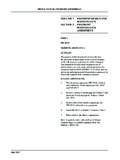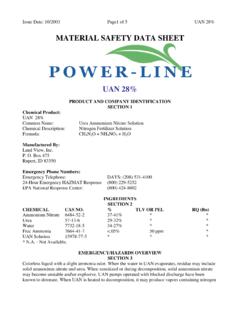Transcription of ISSUES - An official website of the United States …
1 Part I section , etc., Contributions and Gifts 26 CFR : Charitable, etc., contributions and gifts; allowance of deduction. (Also 170; ) Rev. Rul. 2003-28 ISSUES (1) Is a taxpayer s contribution to a qualified charity of a license to use a patent deductible under 170(a) of the Internal Revenue Code if the taxpayer retains any substantial right in the patent? (2) Is a taxpayer s contribution to a qualified charity of a patent subject to a conditional reversion deductible under 170(a)? (3) Is a taxpayer s contribution to a qualified charity of a patent subject to a license or transfer restriction deductible under 170(a)? FACTS Situation 1. X contributes to University, an organization described in 170(c) (qualified charity), a license to use a patent, but retains the right to license the patent to others.
2 Situation 2. Y contributes a patent to University subject to the condition that A, a faculty member of University and an expert in the technology covered by the patent, continue to be a faculty member of University during the remaining life of the patent. If A ceases to be a member of University s faculty before the patent expires, the patent will revert to Y. The patent will expire 15 years after the date Y contributes it to University. On the date of the contribution, the likelihood that A will cease to be a member of the faculty before the patent expires is not so remote as to be negligible. Situation 3. Z contributes to University all of Z s interests in a patent. The transfer agreement provides that University may not sell or license the patent for a period of 3 years after the transfer.
3 This restriction does not result in any benefit to Z, and under no circumstances can the patent revert to Z. LAW AND ANALYSIS Issue (1) section 170(a) provides, subject to certain limitations, a deduction for any charitable contribution, as defined in 170(c), payment of which is made within the taxable year. section 170(f)(3) denies a charitable contribution deduction for certain contributions of partial interests in property. section 170(f)(3)(A) denies a charitable contribution deduction for a contribution of less than the taxpayer's entire interest in property unless the value of the interest contributed would be allowable as a deduction under 170(f)(2) if the donor were to transfer the interest in trust. section 170(f)(2) allows a charitable contribution deduction, in the case of property that the donor transfers in trust, if the trust is a charitable remainder annuity trust, a charitable remainder unitrust, or a pooled income fund.
4 Further, 170(f)(2) allows a deduction for the value of an interest in property (other than a remainder interest) that the donor transfers in trust if the interest is in the form of a guaranteed annuity or the trust instrument specifies that the interest is a fixed percentage, distributed yearly, of the fair market value of the trust property (to be determined yearly) and the grantor is treated as the owner of such interest for purposes of applying 671. By its terms, 170(f)(3)(A) does not apply to, and therefore does not disallow a deduction for, a contribution of an interest that, even though partial, is the taxpayer's entire interest in the property. If, however, the property in which such partial interest exists was divided in order to create such interest, and thus avoid 170(f)(3)(A), a deduction is not allowed.
5 section (a)(2)(i) of the Income Tax Regulations. Sections 170(f)(3)(B)(ii) and (b)(1) allow a deduction under 170 for a contribution not in trust of a partial interest that is less than the donor's entire interest in property if the partial interest is an undivided portion of the donor's entire interest. An undivided portion of a donor's entire interest in property consists of a fraction or percentage of each and every substantial interest or right owned by the donor in such property and must extend over the entire term of the donor s interest in such property and in other property into which such property is converted. A charitable contribution in perpetuity of an interest in property not in trust does not constitute a contribution of an undivided portion of the donor s entire interest if the donor transfers some specific rights and retains other substantial rights.
6 In enacting 170(f)(3), Congress was concerned with situations in which taxpayers might obtain a double benefit by taking a deduction for the present value of a contributed interest while also excluding from income subsequent receipts from the donated interest. In addition, Congress was concerned with situations in which, because the charity does not obtain all or an undivided portion of significant rights in the property, the amount of a charitable contribution deduction might not correspond to the value of the benefit ultimately received by the charity. The legislative solution was to guard against the possibility that such problems might arise by denying a deduction in situations involving partial interests, unless the contribution is cast in certain prescribed forms.
7 See Rep. No. 91-413 at 57-58 (1969), 1969-3 200, 237-239; S. Rep. No. 91-552 at 87 (1969), 1969-3 423, 479. The scope of 170(f)(3) thus extends beyond situations in which there is actual or probable manipulation of the non-charitable interest to the detriment of the charitable interest, or situations in which the donor has merely assigned the right to future income. Rev. Rul. 88-37, 1988-1 97. section 170(f)(3)(A) and (a)(1) treat a contribution of the right to use property that the donor owns, such as a contribution of a rent-free lease, as a contribution of less than the taxpayer s entire interest in the property. Similarly, if a taxpayer contributes an interest in motion picture films, but retains the right to make reproductions of such films and exploit the reproductions commercially, (b)(1)(i) treats the contribution as one of less than the taxpayer s entire interest in the property.
8 In both cases, the taxpayer has not contributed an undivided portion of its entire interest in the property. Accordingly, neither contribution is deductible under 170(a). In Situation 1, X contributes a license to use a patent, but retains a substantial right, , the right to license the patent to others. The license granted to University is similar to the rent-free lease described in (a)(1) and the partial interest in motion picture films described in (b)(1)(i), in that it constitutes neither X s entire interest in the patent, nor a fraction or percentage of each and every substantial interest or right that X owns in the patent. As a result, the contribution in Situation 1 constitutes a transfer of a partial interest, and no deduction under 170(a) is allowable.
9 The result would be the same if X had retained any other substantial right in the patent. For example, no deduction would be allowable if X had contributed the patent (or license to use the patent) solely for use in a particular geographic area while retaining the right to use the patent (or license) in other geographic areas. Issue (2) section (e) provides that if, as of the date of a gift, a transfer of property for charitable purposes is dependent upon the performance of some act or the happening of a precedent event in order for it to become effective, no deduction is allowable unless the possibility that the charitable transfer will not become effective is so remote as to be negligible. Similarly, under (a)(3), if, as of the date of a gift, a transfer of property for charitable purposes may be defeated by the performance of some act or the happening of some event, no deduction is allowable unless the possibility that such act or event will occur is so remote as to be negligible.
10 In Situation 2, Y s contribution of the patent is contingent upon A continuing as a member of University s faculty for an additional 15 years, the remaining life of the patent. On the date of the contribution, the possibility that A will cease to be a member of the faculty before the expiration of the patent is not so remote as to be negligible. Therefore, no deduction is allowable under 170(a). Issue (3) section (c)(1) provides that if a charitable contribution is made in property other than money, the amount of the contribution is the fair market value of the property at the time of the contribution, reduced as provided in 170(e). section (c)(2) provides that the fair market value is the price at which the property would change hands between a willing buyer and a willing seller, neither being under any compulsion to buy or sell and both having reasonable knowledge of relevant facts.













